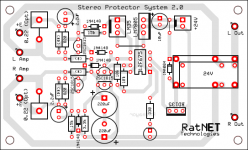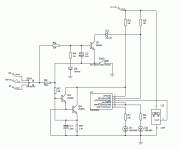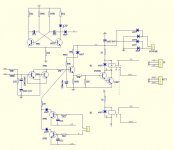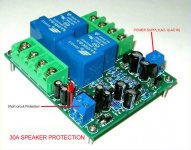<snip>
Alternatively use a fast blow fuse.
Fuses suck. They blow right after the amplifier fails. How about don't fool with the wires while it's running? After I blew up enough amps I decided not to mess with the wiring while it's playing and haven't had an issue in over 30 years.
G²
Fuses suck. They blow right after the amplifier fails. How about don't fool with the wires while it's running? After I blew up enough amps I decided not to mess with the wiring while it's playing and haven't had an issue in over 30 years.
G²
I have had some success with fuses.
I tripped over a speaker wire and shorted it out and the fuse blew before the amp. I guess its getting the fuse value right, not so small it blows for no reason and not so big it doesnt blow at all.
Transistor is the fastest fuse...
Amplifier must have all protections included in it's own circuit. It is almost impostble to do it ,,outboard,,
But of course fuse can work ..... at least sometimes and it depends what is the amp....build for. If you need it to power some pub....sound system than is more than ok. In case of hi-end, no thanks....it is not just a wite in glass tube but is unlinear element in pwr rails.....or in the signal chain.....it depends. But one thing is sure. In terms of safety very recomended to prevent fire.....or at leat high damage...
Regards, Taj
Amplifier must have all protections included in it's own circuit. It is almost impostble to do it ,,outboard,,
But of course fuse can work ..... at least sometimes and it depends what is the amp....build for. If you need it to power some pub....sound system than is more than ok. In case of hi-end, no thanks....it is not just a wite in glass tube but is unlinear element in pwr rails.....or in the signal chain.....it depends. But one thing is sure. In terms of safety very recomended to prevent fire.....or at leat high damage...
Regards, Taj
Mr Murphy says that a $10 transistor always blows before a 10 cent fuse. 
In This amp I am experimenting with control/protection circuits. Although this one is lower power ~30W(avg)/ch, it uses rail switches for the output stage. The circuit design allows for the entire output stage and drivers to be switched off in the event of a fault. I set this circuit up for a maximum allowable current of 6A. If more tries to flow, then the control circuit not only releases the relay, it switches off the output stage must faster than a blowing fuse. Shorting out the speaker wires simply makes the amp switch back into 'stand-by' mode. I am making a scaled up version of this circuit and intend to apply the same principles. I prefer to control the power rails instead of using something like a crow bar. That concept protects the speaker at the expense of the amplifier.
In This amp I am experimenting with control/protection circuits. Although this one is lower power ~30W(avg)/ch, it uses rail switches for the output stage. The circuit design allows for the entire output stage and drivers to be switched off in the event of a fault. I set this circuit up for a maximum allowable current of 6A. If more tries to flow, then the control circuit not only releases the relay, it switches off the output stage must faster than a blowing fuse. Shorting out the speaker wires simply makes the amp switch back into 'stand-by' mode. I am making a scaled up version of this circuit and intend to apply the same principles. I prefer to control the power rails instead of using something like a crow bar. That concept protects the speaker at the expense of the amplifier.

short circuit protection
I am making a scaled up version of this circuit and intend to apply the same principles. I prefer to control the power rails instead of using something like a crow bar. That concept protects the speaker at the expense of the amplifier.
Hi CBS240
greetings thanks for replying nice to hear you are also working on protection its good to have protection in amps mistakes do occur while hooking up speakers the ultimate protection by esperado parts are hard to get and ds
pcb OMNI by dr bora works if you short the speaker wires or load impedance is
below 2 ohms but on removing the short it does not reset again it would be nice
if you can share your project if possible
warm regards
andrew lebon
I am making a scaled up version of this circuit and intend to apply the same principles. I prefer to control the power rails instead of using something like a crow bar. That concept protects the speaker at the expense of the amplifier.
Hi CBS240
greetings thanks for replying nice to hear you are also working on protection its good to have protection in amps mistakes do occur while hooking up speakers the ultimate protection by esperado parts are hard to get and ds
pcb OMNI by dr bora works if you short the speaker wires or load impedance is
below 2 ohms but on removing the short it does not reset again it would be nice
if you can share your project if possible
warm regards
andrew lebon
Attachments
I'm really glad you guys brought this subject up. I recently bought a speaker protection circuit from ebay and it has a short circuit feature. The DC protection works fine but I don't know how to hook up the short circuit portion. Perhaps one of you can tell me how this is hooked up and if it is worth bothering with. I am attaching the schematic.
Thanks, Terry
Thanks, Terry
Attachments
It's very basic long-term over-current protection but better than nothing, I suppose.
The 2-pin connector near the bottom end of the schematic is used for that. L connects between the upper output transistor's emitter and its emitter resistor on the left channel, R same for the right channel. Protection should engage whenever average current becomes larger than ~0.6 V / Re.
The 2-pin connector near the bottom end of the schematic is used for that. L connects between the upper output transistor's emitter and its emitter resistor on the left channel, R same for the right channel. Protection should engage whenever average current becomes larger than ~0.6 V / Re.
Ebay links don't seem to work on this forum. If you go to ebay and search for "30A Speaker protection board DIY Kit including 7812" you will find it. There are a few folks selling it. The one I bought is item #221255947264. They could not answer my question about hooking up the short circuit. They actually asked me to send them the solution when I get it figured out so they can help folks in the future. 
Sgrossklass,
Are you saying I need to attach between the output emitter and its emitter resistor? One to the left channel and the other to the left channel? Does it matter which rail?
Thanks, Terry
Sgrossklass,
Are you saying I need to attach between the output emitter and its emitter resistor? One to the left channel and the other to the left channel? Does it matter which rail?
Thanks, Terry
30A Speaker Protection Board DIY Kit Including 7812 | eBay
THANKS Terry finished making the pcb hope it works
warm regards
andrew
THANKS Terry finished making the pcb hope it works
warm regards
andrew
Hi Terry, hows the leach amps doing? after all the work and repair notes on them last year you got there in the end.
Just had a quick look over the protection circuit and noticed it does not give thermal cut in case modules over heat..also if need be it's timing cap can be changed to speed up on time say to 2 seconds. One, is it's relay 12 volts or 24?
kind regards A.
Just had a quick look over the protection circuit and noticed it does not give thermal cut in case modules over heat..also if need be it's timing cap can be changed to speed up on time say to 2 seconds. One, is it's relay 12 volts or 24?
kind regards A.
- Home
- Amplifiers
- Solid State
- diy short circuit protection



